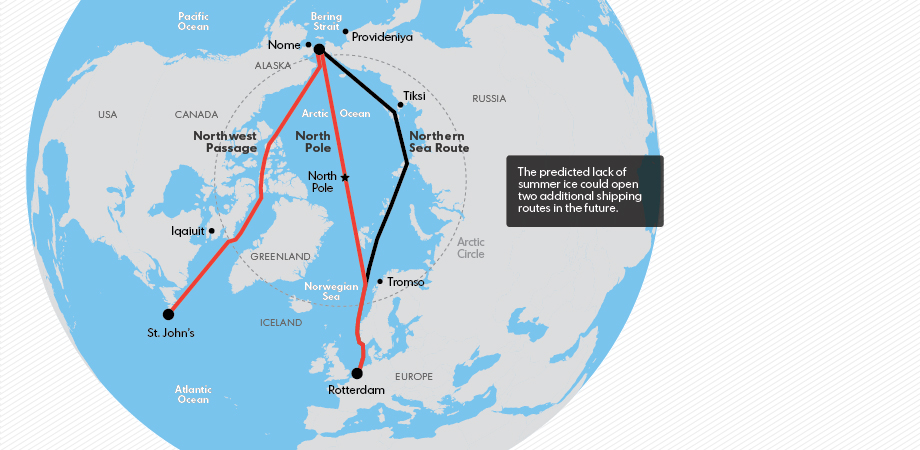Global warming could help Arctic shipping

A study suggests that global warming is opening up a first-time chance to cruise through the Northwest Passage, which could translate into big savings in time and money for shippers.
Who said global warming is all bad?
There will certainly be many more negative effects than positive ones from climate change. But most shipping routes across the Arctic Ocean — which have been ice-covered and impassable since humans invented ships millenniums ago — could be open to ships for the first time by midcentury, thanks to climate change, a new study suggests.
This includes shipping directly across the North Pole -- which has never been done -- or through the famed Northwest Passage, a sea route from Newfoundland toward the Bering Strait. The study appears in Monday's edition of the Proceedings of the National Academy of Sciences Plus.
"Nobody's ever talked about shipping over the top of the North Pole," according to study lead author Laurence Smith, a geography professor at UCLA. "This is an entirely unexpected possibility."
The earliest that sea routes would be taken directly over the North Pole and through the famed Northwest Passage would likely be in the 2040s or 2050s, Smith says. This sort of shipping would also occur only in late summer and early autumn, he adds: The prime month would be September, when Arctic sea ice is at its annual minimum.
"The development is both exciting from an economic development point of view and worrisome in terms of safety, both for the Arctic environment and for the ships themselves," Smith says.
Going directly across the Arctic, or through the Northwest Passage, could lead to significant savings in time and money for shippers. For instance, Smith estimates that traveling from Rotterdam to the Bering Strait via the Northern Sea Route would take almost 19 days, while traveling across the North Pole could be done in 14.6 days.
Ships that use the North Pole route, though, will still need to be special ice-breaking ships, due to random floating ice that still remains on that route. But regular ships -- which make up about 99% of the world's fleet, Smith says, might be able to use the Northwest Passage.
In the past couple of summers, a few dozen ice-breaking ships have traversed the Arctic through the Northern Sea Route, which is controlled by Russia, who "charge a lot of money" to use it, Smith says.
Smith and his team used computer model simulations of future climate warming in their study.
No part of the world has seen as much dramatic warming in recent decades as has the Arctic. Since the 1980s, average temperatures in the Arctic have risen faster than the global average. Last September, sea ice extent — or the amount of area covered by sea ice as observed from above — reached the minimum amount in satellite records (1979-present), according to the National Oceanic and Atmospheric Administration's annual Arctic Report Card.
Most of the Arctic Ocean currently is controlled by five countries — the USA, Canada, Russia, Denmark and Norway — all of whom have a coastline on the ocean. The center of it, however, which includes the North Pole, is considered to be in international waters.
The new shipping routes in the Arctic won't replace the routes through the Panama or Suez Canals, which remain the primary routes for worldwide shipping.
Given this potential for new shipping routes in the Arctic, NOAA recently issued a plan for updated Arctic maps as part of a major effort to improve navigation for Arctic areas experiencing increasing vessel traffic as ice disappears.
"Ships need updated charts with precise and accurate measurements," said Capt. Doug Baird, chief of NOAA's Coast Survey's marine chart division. "We don't have decades to get it done. Ice diminishment is here now."
HEADLINES
- Do shipping markets want Biden or Trump for the win?
- All 18 crew safe after fire on Japanese-owned tanker off Singapore
- Singapore launching $44m co-investment initiative for maritime tech start-ups
- Cosco debuts Global Shipping Industry Chain Cooperation Initiative
- US warns of more shipping sanctions
- China continues seaport consolidation as Dalian offer goes unconditional